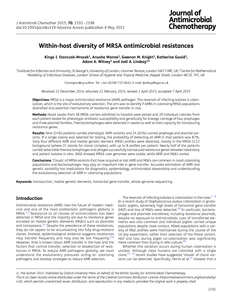Stanczak-Mrozek, KI; Manne, A; Knight, GM; Gould, K; Witney, AA; Lindsay, JA
(2015)
Within-host diversity of MRSA antimicrobial resistances.
Journal of Antimicrobial Chemotherapy, 70 (8).
pp. 2191-2198.
https://doi.org/10.1093/jac/dkv119
SGUL Authors: Gould, Katherine Ann Lindsay, Jodi Anne Witney, Adam Austin
![[img]](https://openaccess.sgul.ac.uk/107464/1.hassmallThumbnailVersion/Within-host%20diversity%20of%20MRSA%20antimicrobial%20resistances..pdf)  Preview |
|
["document_typename_cannot open `/data/SGUL/sgul/eprints3/archives/sgul/documents/disk0/00/10/74/64/01/Within-host' (No such file or directory)
cannot open `diversity' (No such file or directory)
cannot open `of' (No such file or directory)
cannot open `MRSA' (No such file o" not defined]
Published Version
Available under License Creative Commons Attribution.
Download (385kB)
| Preview
|
Abstract
OBJECTIVES: MRSA is a major antimicrobial resistance (AMR) pathogen. The reservoir of infecting isolates is colonization, which is the site of evolutionary selection. The aim was to identify if AMRs in colonizing MRSA populations diversified and potential mechanisms of resistance gene transfer in vivo. METHODS: Nasal swabs from 38 MRSA carriers admitted to hospital were plated and 20 individual colonies from each patient tested for phenotypic antibiotic susceptibility and genetically for lineage, carriage of four prophages and three plasmid families. Free bacteriophages were detected in swabs as well as their capacity for transducing resistance genes. RESULTS: Nine (24%) patients carried phenotypic AMR variants and 24 (63%) carried prophage and plasmid variants. If a single colony was selected for testing, the probability of detecting all AMR in that patient was 87%. Sixty-four different AMR and mobile genetic element (MGE) profiles were detected, mostly in the MRSA CC22 background (where CC stands for clonal complex), with up to 8 profiles per patient. Nearly half of the patients carried detectable free bacteriophages and phages successfully transduced resistance genes between laboratory and patient isolates in vitro. WGS showed MRSA core genomes were stable, while AMR and MGEs varied. CONCLUSIONS: 'Clouds' of MRSA variants that have acquired or lost AMR and MGEs are common in nasal colonizing populations and bacteriophages may play an important role in gene transfer. Accurate estimation of AMR and genetic variability has implications for diagnostics, epidemiology, antimicrobial stewardship and understanding the evolutionary selection of AMR in colonizing populations.
| Item Type: |
Article
|
| Additional Information: |
© The Author 2015. Published by Oxford University Press on behalf of the British Society for Antimicrobial Chemotherapy.
This is an Open Access article distributed under the terms of the Creative Commons Attribution License (http://creativecommons.org/licenses/by/
4.0/), which permits unrestricted reuse, distribution, and reproduction in any medium, provided the original work is properly cited. |
| Keywords: |
horizontal gene transfer, mobile genetic elements, transduction, whole-genome sequencing, transduction, mobile genetic elements, horizontal gene transfer, whole-genome sequencing, Microbiology, 1115 Pharmacology And Pharmaceutical Sciences, 0605 Microbiology, 1108 Medical Microbiology |
| SGUL Research Institute / Research Centre: |
Academic Structure > Infection and Immunity Research Institute (INII) |
| Journal or Publication Title: |
Journal of Antimicrobial Chemotherapy |
| Language: |
eng |
| Dates: |
| Date | Event |
|---|
| 8 May 2015 | Published |
|
| Publisher License: |
Creative Commons: Attribution 4.0 |
| Projects: |
| Project ID | Funder | Funder ID |
|---|
| G0900205 | Medical Research Council | UNSPECIFIED |
|
| PubMed ID: |
25957384 |
| Web of Science ID: |
WOS:000359723600003 |
 |
Go to PubMed abstract |
| URI: |
https://openaccess.sgul.ac.uk/id/eprint/107464 |
| Publisher's version: |
https://doi.org/10.1093/jac/dkv119 |
Statistics
Item downloaded times since 04 Mar 2016.
Actions (login required)
 |
Edit Item |



